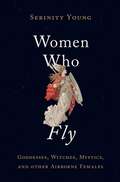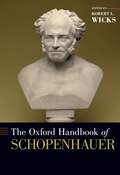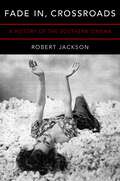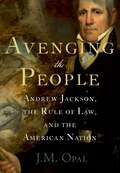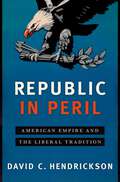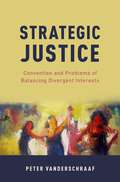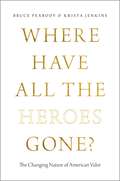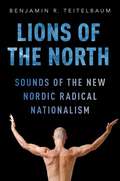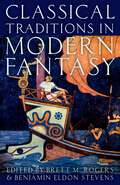- Table View
- List View
Women Who Fly: Goddesses, Witches, Mystics, and other Airborne Females
by Serinity YoungFrom the beautiful apsaras of Hindu myth to the swan maidens of European fairy tales, stories of flying women-some carried by wings, others by clouds, rainbows, floating scarves, and flying horses-reveal the perennial fascination with and ambivalence about female power and sexuality. In Women Who Fly, Serinity Young examines the motif of the flying woman as it appears in a wide variety of cultures and historical periods, in legends, myths, rituals, sacred narratives, and artistic productions. She considers supernatural women like the Valkyries of Norse legend, who transport men to immortality; winged deities like the Greek goddesses Iris and Nike; figures of terror like the Furies, witches, and succubi; airborne Christian mystics; and wayward, dangerous women like Lilith and Morgan le Fay. Looking beyond the supernatural, Young examines the modern mythology surrounding twentieth-century female aviators like Amelia Earhart and Hanna Reitsch. Throughout, Young demonstrates that female power has always been inextricably linked with female sexuality and that the desire to control it is a pervasive theme in these stories. This is vividly depicted, for example, in the twelfth-century Niebelungenlied, in which the proud warrior-queen Brünnhilde loses her great physical strength when she is tricked into surrendering her virginity. Even in the twentieth-century the same idea is reflected in the exploits of the comic book and film character Wonder Woman who, Young suggests, retains her physical strength only because her love for fellow aviator Steve Trevor goes unrequited. The first book to systematically chronicle the figure of the flying woman in myth, literature, art, and pop culture, Women Who Fly offers a fresh look at the ways in which women have both influenced and been understood by society and religious traditions throughout the ages and around the world.
Policing Transnational Protest: Liberal Imperialism and the Surveillance of Anticolonialists in Europe, 1905-1945
by Daniel BrückenhausPolicing Transnational Protest offers an original perspective on the history of police surveillance of anticolonial activists in France, Britain, and Germany in the first half of the twentieth century. Tracing the undertakings of anticolonial activists from Asia, Africa, and the Middle East in Europe and reconstructing the reaction of European governments, it illuminates the increasing cooperation of the police and secret services to monitor the activities of the "oriental revolutionaries" and curb their room to maneuver. But those efforts had an unintended inflammatory effect, provoking both supporters and opponents of colonial rule to understand the conflict in increasingly global and trans-imperial terms. The surveillance also exacerbated tensions between Europeans friendly to the anticolonial cause, and those who prioritized imperial security over civil liberties and national sovereignty. Tracking growing levels of transnational government cooperation against anticolonialists, this book pays special attention to Germany, where many activists were able to carry out their political work in relative safety after escaping surveillance in Britain and France. By analyzing the emergence of ever more sophisticated counter-terrorism schemes and surveillance apparatuses, Brückenhaus also contributes a pre-history of similar phenomena characterizing the post-9/11 world. He shows how, then as now, an intensification of a "war on terror" went hand in hand with concerns about encroachments on civil liberties, often expressed in open protest against such governance measures. Policing Transnational Protest informs current debates about intelligence gathering and surveillance in several European countries as well as their new cooperative partner, the United States.
Policing Transnational Protest: Liberal Imperialism and the Surveillance of Anticolonialists in Europe, 1905-1945
by Daniel BrückenhausPolicing Transnational Protest offers an original perspective on the history of police surveillance of anticolonial activists in France, Britain, and Germany in the first half of the twentieth century. Tracing the undertakings of anticolonial activists from Asia, Africa, and the Middle East in Europe and reconstructing the reaction of European governments, it illuminates the increasing cooperation of the police and secret services to monitor the activities of the "oriental revolutionaries" and curb their room to maneuver. But those efforts had an unintended inflammatory effect, provoking both supporters and opponents of colonial rule to understand the conflict in increasingly global and trans-imperial terms. The surveillance also exacerbated tensions between Europeans friendly to the anticolonial cause, and those who prioritized imperial security over civil liberties and national sovereignty. Tracking growing levels of transnational government cooperation against anticolonialists, this book pays special attention to Germany, where many activists were able to carry out their political work in relative safety after escaping surveillance in Britain and France. By analyzing the emergence of ever more sophisticated counter-terrorism schemes and surveillance apparatuses, Brückenhaus also contributes a pre-history of similar phenomena characterizing the post-9/11 world. He shows how, then as now, an intensification of a "war on terror" went hand in hand with concerns about encroachments on civil liberties, often expressed in open protest against such governance measures. Policing Transnational Protest informs current debates about intelligence gathering and surveillance in several European countries as well as their new cooperative partner, the United States.
The Oxford Handbook of Schopenhauer (Oxford Handbooks)
More than two hundred years after the publication of his seminal The World as Will and Representation, Arthur Schopenhauer's influence is still felt in philosophy and beyond. As one of the most readable and central philosophers of the 19th century, his work inspired the most influential thinkers and artists of his time, including Nietzsche, Freud, and Wagner. Though known primarily as a herald of philosophical pessimism, the full range of his contributions is displayed here in a collection of thirty-one essays on the forefront of Schopenhauer scholarship. Essays written by contemporary Schopenhauer scholars explore his central notions, including the will, empirical knowledge, and the sublime, and widens to the interplay of ethics and religion with Schopenhauer's philosophy. Authors confront difficult aspects of Schopenhauer's work and legacy--for example, the extent to which Schopenhauer adopted ideas from his predecessors compared to how much was original and visionary in his central claim that reality is a blind, senseless "will," the effectiveness of his philosophy in the field of scientific explanation and extrasensory phenomena, and the role of beauty and sublimity in his outlook. Essays also challenge prevailing assumptions about Schopenhauer by exploring the fundamental role of compassion in his moral theory, the Hindu, Christian, and Buddhist aspects of his philosophy, and the importance of asceticism in his views on the meaning of life. The collection is an internationally constituted work that reflects upon Schopenhauer's philosophy with authors presently working across the globe. It demonstrates fully the richness of Schopenhauer's work and his lasting impact on philosophy and psychoanalysis, as well as upon music, the visual arts, and literature.
The Oxford Handbook of Schopenhauer (Oxford Handbooks)
by Robert L. WicksMore than two hundred years after the publication of his seminal The World as Will and Representation, Arthur Schopenhauer's influence is still felt in philosophy and beyond. As one of the most readable and central philosophers of the 19th century, his work inspired the most influential thinkers and artists of his time, including Nietzsche, Freud, and Wagner. Though known primarily as a herald of philosophical pessimism, the full range of his contributions is displayed here in a collection of thirty-one essays on the forefront of Schopenhauer scholarship. Essays written by contemporary Schopenhauer scholars explore his central notions, including the will, empirical knowledge, and the sublime, and widens to the interplay of ethics and religion with Schopenhauer's philosophy. Authors confront difficult aspects of Schopenhauer's work and legacy--for example, the extent to which Schopenhauer adopted ideas from his predecessors compared to how much was original and visionary in his central claim that reality is a blind, senseless "will," the effectiveness of his philosophy in the field of scientific explanation and extrasensory phenomena, and the role of beauty and sublimity in his outlook. Essays also challenge prevailing assumptions about Schopenhauer by exploring the fundamental role of compassion in his moral theory, the Hindu, Christian, and Buddhist aspects of his philosophy, and the importance of asceticism in his views on the meaning of life. The collection is an internationally constituted work that reflects upon Schopenhauer's philosophy with authors presently working across the globe. It demonstrates fully the richness of Schopenhauer's work and his lasting impact on philosophy and psychoanalysis, as well as upon music, the visual arts, and literature.
Fade In, Crossroads: A History of the Southern Cinema
by Robert JacksonHow did the US South contribute to the development of film? And how did film shape the modern South? In Fade In, Crossroads, Robert Jackson tells the story of the relationships between southerners and motion pictures from the silent era through the golden age of Hollywood. Jackson reveals the profound consequences of the coincidence of the rise and fall of the American film industry with the rise and fall of the South's most important modern product and export: Jim Crow segregation. He considers southern historical legacies on film, from popular Civil War films and comparably popular lynching films emerging in a time of prolific lynching in the South, to the resilient race film industry whose African American filmmakers forged an independent cinematic movement in defiance of the racial restrictions of both the South and Hollywood. He also traces the influence of film on future participants in the Civil Rights Movement, from prominent leaders such as Martin Luther King and Thurgood Marshall to film-industry veterans like Lena Horne and Paul Robeson to the millions of ordinary people, black and white, who found themselves caught up in the struggle for racial equality in the modern United States.
FADE IN, CROSSROADS C: A History of the Southern Cinema
by Robert JacksonHow did the US South contribute to the development of film? And how did film shape the modern South? In Fade In, Crossroads, Robert Jackson tells the story of the relationships between southerners and motion pictures from the silent era through the golden age of Hollywood. Jackson reveals the profound consequences of the coincidence of the rise and fall of the American film industry with the rise and fall of the South's most important modern product and export: Jim Crow segregation. He considers southern historical legacies on film, from popular Civil War films and comparably popular lynching films emerging in a time of prolific lynching in the South, to the resilient race film industry whose African American filmmakers forged an independent cinematic movement in defiance of the racial restrictions of both the South and Hollywood. He also traces the influence of film on future participants in the Civil Rights Movement, from prominent leaders such as Martin Luther King and Thurgood Marshall to film-industry veterans like Lena Horne and Paul Robeson to the millions of ordinary people, black and white, who found themselves caught up in the struggle for racial equality in the modern United States.
Avenging the People: Andrew Jackson, the Rule of Law, and the American Nation
by J.M. OpalMost Americans know Andrew Jackson as a frontier rebel against political and diplomatic norms, a "populist" champion of ordinary people against the elitist legacy of the Founding Fathers. Many date the onset of American democracy to his 1829 inauguration. Despite his reverence for the "sovereign people," however, Jackson spent much of his career limiting that sovereignty, imposing new and often unpopular legal regimes over American lands and markets. He made his name as a lawyer, businessman, and official along the Carolina and Tennessee frontiers, at times ejecting white squatters from native lands and returning slaves to native planters in the name of federal authority and international law. On the other hand, he waged total war on the Cherokees and Creeks who terrorized western settlements and raged at the national statesmen who refused to "avenge the blood" of innocent colonists. During the long war in the south and west from 1811 to 1818 he brushed aside legal restraints on holy genocide and mass retaliation, presenting himself as the only man who would protect white families from hostile empires, "heathen" warriors, and rebellious slaves. He became a towering hero to those who saw the United States as uniquely lawful and victimized. And he used that legend to beat back a range of political, economic, and moral alternatives for the republican future. Drawing from new evidence about Jackson and the southern frontiers, Avenging the People boldly reinterprets the grim and principled man whose version of American nationhood continues to shape American democracy.
Avenging the People: Andrew Jackson, the Rule of Law, and the American Nation
by J.M. OpalMost Americans know Andrew Jackson as a frontier rebel against political and diplomatic norms, a "populist" champion of ordinary people against the elitist legacy of the Founding Fathers. Many date the onset of American democracy to his 1829 inauguration. Despite his reverence for the "sovereign people," however, Jackson spent much of his career limiting that sovereignty, imposing new and often unpopular legal regimes over American lands and markets. He made his name as a lawyer, businessman, and official along the Carolina and Tennessee frontiers, at times ejecting white squatters from native lands and returning slaves to native planters in the name of federal authority and international law. On the other hand, he waged total war on the Cherokees and Creeks who terrorized western settlements and raged at the national statesmen who refused to "avenge the blood" of innocent colonists. During the long war in the south and west from 1811 to 1818 he brushed aside legal restraints on holy genocide and mass retaliation, presenting himself as the only man who would protect white families from hostile empires, "heathen" warriors, and rebellious slaves. He became a towering hero to those who saw the United States as uniquely lawful and victimized. And he used that legend to beat back a range of political, economic, and moral alternatives for the republican future. Drawing from new evidence about Jackson and the southern frontiers, Avenging the People boldly reinterprets the grim and principled man whose version of American nationhood continues to shape American democracy.
Which Side Are You On?: 20th Century American History in 100 Protest Songs
by James SullivanWhen he emerged from the nightclubs of Greenwich Village, Bob Dylan was often identified as a "protest" singer. As early as 1962, however, Dylan was already protesting the label: "I don't write no protest songs," he told his audience on the night he debuted "Blowin' in the Wind." "Protest" music is largely perceived as an unsubtle art form, a topical brand of songwriting that preaches to the converted. But popular music of all types has long given listeners food for thought. Fifty years before Vietnam, before the United States entered World War I, some of the most popular sheet music in the country featured anti-war tunes. The labor movement of the early decades of the century was fueled by its communal "songbook." The Civil Rights movement was soundtracked not just by the gorgeous melodies of "Strange Fruit" and "A Change Is Gonna Come," but hundreds of other gospel-tinged ballads and blues. In Which Side Are You On, author James Sullivan delivers a lively anecdotal history of the progressive movements that have shaped the growth of the United States, and the songs that have accompanied and defined them. Covering one hundred years of social conflict and progress across the twentieth century and into the early years of the twenty-first, this book reveals how protest songs have given voice to the needs and challenges of a nation and asked its citizens to take a stand--asking the question "Which side are you on?"
Which Side Are You On?: 20th Century American History in 100 Protest Songs
by James SullivanWhen he emerged from the nightclubs of Greenwich Village, Bob Dylan was often identified as a "protest" singer. As early as 1962, however, Dylan was already protesting the label: "I don't write no protest songs," he told his audience on the night he debuted "Blowin' in the Wind." "Protest" music is largely perceived as an unsubtle art form, a topical brand of songwriting that preaches to the converted. But popular music of all types has long given listeners food for thought. Fifty years before Vietnam, before the United States entered World War I, some of the most popular sheet music in the country featured anti-war tunes. The labor movement of the early decades of the century was fueled by its communal "songbook." The Civil Rights movement was soundtracked not just by the gorgeous melodies of "Strange Fruit" and "A Change Is Gonna Come," but hundreds of other gospel-tinged ballads and blues. In Which Side Are You On, author James Sullivan delivers a lively anecdotal history of the progressive movements that have shaped the growth of the United States, and the songs that have accompanied and defined them. Covering one hundred years of social conflict and progress across the twentieth century and into the early years of the twenty-first, this book reveals how protest songs have given voice to the needs and challenges of a nation and asked its citizens to take a stand--asking the question "Which side are you on?"
Jewish History: A Very Short Introduction (Very Short Introductions)
by David N. MyersHow have the Jews survived? For millennia, they have defied odds by overcoming the travails of exile, persecution, and recurring plans for their annihilation. Many have attempted to explain this singular success as a result of divine intervention. In this engaging book, David N. Myers charts the long journey of the Jews through history. At the same time, it points to two unlikely-and decidedly this-worldly--factors to explain the survival of the Jews: antisemitism and assimilation. Usually regarded as grave dangers, these two factors have continually interacted with one other to enable the persistence of the Jews. At every turn in their history, not just in the modern age, Jews have adapted to new environments, cultures, languages, and social norms. These bountiful encounters with host societies have exercised the cultural muscle of the Jews, preventing the atrophy that would have occurred if they had not interacted so extensively with the non-Jewish world. It is through these encounters--indeed, through a process of assimilation--that Jews came to develop distinct local customs, speak many different languages, and cultivate diverse musical, culinary, and intellectual traditions. Left unchecked, the Jews' well-honed ability to absorb from surrounding cultures might have led to their disappearance. And yet, the route toward full and unbridled assimilation was checked by the nearly constant presence of hatred toward the Jew. Anti-Jewish expression and actions have regularly accompanied Jews throughout history. Part of the ironic success of antisemitism is its malleability, its talent in assuming new forms and portraying the Jew in diverse and often contradictory images--for example, at once the arch-capitalist and revolutionary Communist. Antisemitism not only served to blunt further assimilation, but, in a paradoxical twist, affirmed the Jew's sense of difference from the host society. And thus together assimilation and antisemitism (at least up to a certain limit) contribute to the survival of the Jews as a highly adaptable and yet distinct group.
Republic in Peril: American Empire and the Liberal Tradition
by David C. HendricksonIn Republic in Peril, David C. Hendrickson advances a powerful critique of American policy since the end of the Cold War. America's outsized military spending and global commitments, he shows, undermine rather than uphold international order. They raise rather than reduce the danger of war, imperiling both American security and domestic liberty. An alternative path lies in a new internationalism in tune with the United Nations Charter and the philosophy of republican liberty embraced by America's founders. The sum of the conventional view-touted by the national security establishment and embraced by Hillary Clinton and George W. Bush-is that it is impossible to have a liberal world order unless America has hostile relations with Russia, China, and Iran, together with a shifting cast of lesser states. Donald Trump, iconoclastic is so many ways, promises to bring the militarization of U.S. foreign policy to an entirely new level. But it is precisely those who would lead us into battle with "hostile states" who threaten a liberal world order, because they look to a competition that is to be settled through dominance rather than reciprocity. Formed by ideology, greatly fortified by special interests, the U.S. posture has put it into standing collision with other great powers. The flaws of the U.S.-led world order-a chronic overreliance on force, habitual violations of the rules governing intervention-should not be attributed to liberalism but to a flock of "neo-isms" parading in its name. In searching for a remedy, we must find it by rediscovering, not repudiating, the liberal tradition. Hendrickson offers a panoramic view of America's choices in foreign policy, analyzing the vested interests and ideologies that have justified a sprawling global empire over the last 25 years. Hendrickson recovers the tradition of liberal pluralism, one that sees in nonintervention, the balance of power, and great power concert the formula for a durable peace. Rather than claiming a superior role as judge, jury, and executioner, the United States must share power in accordance with the Golden Rule. It needs restraint rather than braggadocio, acceptance of its role as a nation among the nations rather than arrogant pretensions regarding its exceptional virtue and superior wisdom. Ranging widely, from the classics of American political thought and international theory to the bewildering thicket of hot wars and regional feuds across the globe that embroil America, Hendrickson forcefully shows that the militarization of U.S. foreign policy is deeply at odds with the animating purposes and principles of the American experiment.
Republic in Peril: American Empire and the Liberal Tradition
by David C. HendricksonIn Republic in Peril, David C. Hendrickson advances a powerful critique of American policy since the end of the Cold War. America's outsized military spending and global commitments, he shows, undermine rather than uphold international order. They raise rather than reduce the danger of war, imperiling both American security and domestic liberty. An alternative path lies in a new internationalism in tune with the United Nations Charter and the philosophy of republican liberty embraced by America's founders. The sum of the conventional view-touted by the national security establishment and embraced by Hillary Clinton and George W. Bush-is that it is impossible to have a liberal world order unless America has hostile relations with Russia, China, and Iran, together with a shifting cast of lesser states. Donald Trump, iconoclastic is so many ways, promises to bring the militarization of U.S. foreign policy to an entirely new level. But it is precisely those who would lead us into battle with "hostile states" who threaten a liberal world order, because they look to a competition that is to be settled through dominance rather than reciprocity. Formed by ideology, greatly fortified by special interests, the U.S. posture has put it into standing collision with other great powers. The flaws of the U.S.-led world order-a chronic overreliance on force, habitual violations of the rules governing intervention-should not be attributed to liberalism but to a flock of "neo-isms" parading in its name. In searching for a remedy, we must find it by rediscovering, not repudiating, the liberal tradition. Hendrickson offers a panoramic view of America's choices in foreign policy, analyzing the vested interests and ideologies that have justified a sprawling global empire over the last 25 years. Hendrickson recovers the tradition of liberal pluralism, one that sees in nonintervention, the balance of power, and great power concert the formula for a durable peace. Rather than claiming a superior role as judge, jury, and executioner, the United States must share power in accordance with the Golden Rule. It needs restraint rather than braggadocio, acceptance of its role as a nation among the nations rather than arrogant pretensions regarding its exceptional virtue and superior wisdom. Ranging widely, from the classics of American political thought and international theory to the bewildering thicket of hot wars and regional feuds across the globe that embroil America, Hendrickson forcefully shows that the militarization of U.S. foreign policy is deeply at odds with the animating purposes and principles of the American experiment.
Strategic Justice: Convention and Problems of Balancing Divergent Interests (Oxford Moral Theory)
by Peter VanderschraafIn Strategic Justice, Peter Vanderschraaf argues that justice can be properly understood as a body of special social conventions. The idea that justice is at bottom conventional has ancient roots, but has never been central in philosophy because convention itself has historically been so poorly understood. Vanderschraaf gives a new defense of this idea that integrates insights and arguments of past masters of moral and political philosophy together with recent analytical and empirical concepts and results from the social sciences. One of the substantial contributions of this work is a new account of convention that is sufficiently general for summarizing problems of justice, the social interactions where the interests of the agents involved diverge. Conventions are defined as equilibrium solutions to the games that summarize social interactions having a variety of possible stable resolutions and a corresponding plurality of equilibria. The basic idea that justice consists of a system of rules for mutual advantage is explored in depth using this game-theoretic analysis of convention. Justice is analyzed as a system of conventions that are stable with respect to renegotiation in the face of societal changes such as resource depletion, technological innovation and population decline or growth. This new account of justice-as-convention explains in a cogent and natural way what justice is and why individuals have good reason to obey its requirements. Contrary to what many have thought, this new account shows how the justice-as-convention view can give a good account of why justice requires that the most vulnerable members of society receive protections and benefits from the cooperative surplus created by general compliance with justice.
STRATEGIC JUSTICE OXFMT C: Convention and Problems of Balancing Divergent Interests (Oxford Moral Theory)
by Peter VanderschraafIn Strategic Justice, Peter Vanderschraaf argues that justice can be properly understood as a body of special social conventions. The idea that justice is at bottom conventional has ancient roots, but has never been central in philosophy because convention itself has historically been so poorly understood. Vanderschraaf gives a new defense of this idea that integrates insights and arguments of past masters of moral and political philosophy together with recent analytical and empirical concepts and results from the social sciences. One of the substantial contributions of this work is a new account of convention that is sufficiently general for summarizing problems of justice, the social interactions where the interests of the agents involved diverge. Conventions are defined as equilibrium solutions to the games that summarize social interactions having a variety of possible stable resolutions and a corresponding plurality of equilibria. The basic idea that justice consists of a system of rules for mutual advantage is explored in depth using this game-theoretic analysis of convention. Justice is analyzed as a system of conventions that are stable with respect to renegotiation in the face of societal changes such as resource depletion, technological innovation and population decline or growth. This new account of justice-as-convention explains in a cogent and natural way what justice is and why individuals have good reason to obey its requirements. Contrary to what many have thought, this new account shows how the justice-as-convention view can give a good account of why justice requires that the most vulnerable members of society receive protections and benefits from the cooperative surplus created by general compliance with justice.
WHERE HAVE ALL THE HEROES GONE C: The Changing Nature of American Valor
by Bruce Peabody Krista JenkinsFrom the men and women associated with the American Revolution and Civil War to the seminal figures in the struggles for civil and women's rights, Americans have been fascinated with icons of great achievement, or at least reputation. But who spins today's narratives about American heroism, and to what end? In Where Have All the Heroes Gone?, Bruce Peabody and Krista Jenkins draw on the concept of the American hero to show an important gap between the views of political and media elites and the attitudes of the mass public. The authors contend that important changes over the past half century, including the increasing scope of new media and people's deepening political distrust, have drawn both politicians and producers of media content to the hero meme. However, popular reaction to this turn to heroism has been largely skeptical. As a result, the conversations and judgments of ordinary Americans, government officials, and media elites are often deeply divergent. Investigating the story of American heroes over the past five decades provides a narrative that can teach us about such issues as political socialization, institutional trust, and political communication.
The War Beat, Europe: The American Media at War Against Nazi Germany
by Steven CaseyFrom the North African desert to the bloody stalemate in Italy, from the London blitz to the D-Day beaches, a group of highly courageous and extremely talented American journalists reported the war against Nazi Germany for a grateful audience. Based on a wealth of previously untapped primary sources, War Beat, Europe provides the first comprehensive account of what these reporters witnessed, what they were allowed to publish, and how their reports shaped the home front's perception of some of the most pivotal battles in American history. In a dramatic and fast-paced narrative, Steven Casey takes readers from the inner councils of government, where Franklin D. Roosevelt and George Marshall held clear views about how much blood and gore Americans could stomach, to the command centers in London, Algiers, Naples, and Paris, where many reporters were stuck with the dreary task of reporting the war by communiqué. At the heart of this book is the epic journey of reporters like Wes Gallagher and Don Whitehead of the Associated Press, Drew Middleton of the New York Times, Bill Stoneman of the Chicago Daily News, and John Thompson of the Chicago Tribune; of columnists like Ernie Pyle and Hal Boyle; and of photographers like Margaret Bourke-White and Robert Capa. These men and women risked their lives on countless occasions to get their dispatches and their images back home. In providing coverage of war in an open society, they also balanced the weighty responsibility of adhering to censorship regulations while working to sell newspapers and maintaining American support for the war. These reporters were driven by a combination of ambition, patriotism, and belief in the cause. War Beat, Europe shows how they earned their reputation as America's golden generation of journalists and wrote the first draft of World War II history for posterity.
The War Beat, Europe: The American Media at War Against Nazi Germany
by Steven CaseyFrom the North African desert to the bloody stalemate in Italy, from the London blitz to the D-Day beaches, a group of highly courageous and extremely talented American journalists reported the war against Nazi Germany for a grateful audience. Based on a wealth of previously untapped primary sources, War Beat, Europe provides the first comprehensive account of what these reporters witnessed, what they were allowed to publish, and how their reports shaped the home front's perception of some of the most pivotal battles in American history. In a dramatic and fast-paced narrative, Steven Casey takes readers from the inner councils of government, where Franklin D. Roosevelt and George Marshall held clear views about how much blood and gore Americans could stomach, to the command centers in London, Algiers, Naples, and Paris, where many reporters were stuck with the dreary task of reporting the war by communiqué. At the heart of this book is the epic journey of reporters like Wes Gallagher and Don Whitehead of the Associated Press, Drew Middleton of the New York Times, Bill Stoneman of the Chicago Daily News, and John Thompson of the Chicago Tribune; of columnists like Ernie Pyle and Hal Boyle; and of photographers like Margaret Bourke-White and Robert Capa. These men and women risked their lives on countless occasions to get their dispatches and their images back home. In providing coverage of war in an open society, they also balanced the weighty responsibility of adhering to censorship regulations while working to sell newspapers and maintaining American support for the war. These reporters were driven by a combination of ambition, patriotism, and belief in the cause. War Beat, Europe shows how they earned their reputation as America's golden generation of journalists and wrote the first draft of World War II history for posterity.
Ghettos, Tramps, and Welfare Queens: Down and Out on the Silver Screen
by Stephen PimpareGhettos, Tramps, and Welfare Queens: Down & Out on the Silver Screen explores how American movies have portrayed poor and homeless people from the silent era to today. It provides a novel kind of guide to social policy, exploring how ideas about poor and homeless people have been reflected in popular culture and evaluating those images against the historical and contemporary reality. Richly illustrated and examining nearly 300 American-made films released between 1902 and 2015, Ghettos, Tramps, and Welfare Queens finds and describes representations of poor and homeless people and the places they have inhabited throughout the century-long history of U.S. cinema. It moves beyond the merely descriptive to deliberate whether cinematic representations of homelessness and poverty changed over time, and if there are patterns to be discerned. Ultimately, the text offers a preliminary response to a handful of harder questions about causation and consequence: Why are these portrayals as they are? Where do they come from? Are they a reflection of American attitudes and policies toward marginalized populations, or do they help create them? What does this all mean for politics and policymaking? Of interest to movie buffs and film scholars, cultural critics and historians, policy analysts, and those curious to know more about homelessness and American poverty, Ghettos, Tramps, and Welfare Queens is a unique window into American politics, history, policy, and culture -- it is an entertaining and enlightening journey.
Ghettos, Tramps, and Welfare Queens: Down and Out on the Silver Screen
by Stephen PimpareGhettos, Tramps, and Welfare Queens: Down & Out on the Silver Screen explores how American movies have portrayed poor and homeless people from the silent era to today. It provides a novel kind of guide to social policy, exploring how ideas about poor and homeless people have been reflected in popular culture and evaluating those images against the historical and contemporary reality. Richly illustrated and examining nearly 300 American-made films released between 1902 and 2015, Ghettos, Tramps, and Welfare Queens finds and describes representations of poor and homeless people and the places they have inhabited throughout the century-long history of U.S. cinema. It moves beyond the merely descriptive to deliberate whether cinematic representations of homelessness and poverty changed over time, and if there are patterns to be discerned. Ultimately, the text offers a preliminary response to a handful of harder questions about causation and consequence: Why are these portrayals as they are? Where do they come from? Are they a reflection of American attitudes and policies toward marginalized populations, or do they help create them? What does this all mean for politics and policymaking? Of interest to movie buffs and film scholars, cultural critics and historians, policy analysts, and those curious to know more about homelessness and American poverty, Ghettos, Tramps, and Welfare Queens is a unique window into American politics, history, policy, and culture -- it is an entertaining and enlightening journey.
LIONS OF THE NORTH C: Sounds of the New Nordic Radical Nationalism
by Benjamin R. TeitelbaumOften labeled "neo-Nazis" or "right-wing extremists," radical nationalists in the Nordic countries have always relied on music to voice their opposition to immigration and multiculturalism. These actors shook political establishments throughout Sweden, Denmark, and Norway during the 1980s and 1990s by rallying around white power music and skinhead subculture. But though nationalists once embraced a reputation for crude chauvinism, they are now seeking to reinvent themselves as upstanding and righteous, and they are using music to do it. Lions of the North explores this transformation of anti-immigrant activism in the Nordic countries as it manifests in thought and sound. Offering a rare ethnographic glimpse into controversial and secretive political movements, it investigates changes in the music nationalists make and patronize, reading their puzzling embrace of lite pop, folk music, even rap and reggae as attempts to escape stereotypes and craft a new image for themselves. Lions of the North not only exposes the dynamic relationship between music and politics, but also the ways radical nationalism is adapting to succeed in some of the most liberal societies in the world.
Saving the Sacred Sea: The Power of Civil Society in an Age of Authoritarianism and Globalization
by Kate Pride Brown"Civil society" is a loaded concept in Russia; during the Soviet period, the voices that heralded civil society were the same ones that demanded the Union's dissolution. So, for the Kremlin, civil society is not the guarantor of democracy, but a force that has the power to end governments. This book looks at how civil society negotiates power on a global stage, under Russia's authoritarian regime, and in a particularly isolated and remote part of the world: within environmental activism around Lake Baikal in Siberia. More than a mile deep, Lake Baikal is the oldest, deepest, and most voluminous lake on the Earth, and home to thousands of endemic species. It is also ecologically unique in that it is oxygenated to its maximum depth and supports life even at the lake floor -- a phenomenon occurring nowhere else on the planet. The lake is not just a natural wonder, but home to a strong environmentalist community that works tirelessly to protect the lake from human harm. Environmentalism at Baikal began in the late 1950s, eventually igniting the first national protest in the USSR. They have remained active in some form ever since, across the years of chaos, instability, and crisis, from the opening of Russia to the forces of globalization to the authoritarianism of Putin in the present. This book examines the struggle of Baikal environmentalists to develop a new understanding of civil society under conditions of globalization and authoritarianism. Through extended, historically-informed ethnographic analysis, Kate Pride Brown argues that civil society is engaged with political and economic elites in a dynamic struggle within a field of power. Understanding the field of power helps to explain a number of contradictions. For example, why does civil society seem to both bolster democracy and threaten it? Why do capitalist corporations and environmental organizations form partnerships despite their general hostility toward each other? And why has democracy proven to be so elusive in Russia? The field of power posits new answers to these questions, as Baikal environmental activists struggle to protect and save their Sacred Sea.
SAVING THE SACRED SEA C: The Power of Civil Society in an Age of Authoritarianism and Globalization
by Kate Pride Brown"Civil society" is a loaded concept in Russia; during the Soviet period, the voices that heralded civil society were the same ones that demanded the Union's dissolution. So, for the Kremlin, civil society is not the guarantor of democracy, but a force that has the power to end governments. This book looks at how civil society negotiates power on a global stage, under Russia's authoritarian regime, and in a particularly isolated and remote part of the world: within environmental activism around Lake Baikal in Siberia. More than a mile deep, Lake Baikal is the oldest, deepest, and most voluminous lake on the Earth, and home to thousands of endemic species. It is also ecologically unique in that it is oxygenated to its maximum depth and supports life even at the lake floor -- a phenomenon occurring nowhere else on the planet. The lake is not just a natural wonder, but home to a strong environmentalist community that works tirelessly to protect the lake from human harm. Environmentalism at Baikal began in the late 1950s, eventually igniting the first national protest in the USSR. They have remained active in some form ever since, across the years of chaos, instability, and crisis, from the opening of Russia to the forces of globalization to the authoritarianism of Putin in the present. This book examines the struggle of Baikal environmentalists to develop a new understanding of civil society under conditions of globalization and authoritarianism. Through extended, historically-informed ethnographic analysis, Kate Pride Brown argues that civil society is engaged with political and economic elites in a dynamic struggle within a field of power. Understanding the field of power helps to explain a number of contradictions. For example, why does civil society seem to both bolster democracy and threaten it? Why do capitalist corporations and environmental organizations form partnerships despite their general hostility toward each other? And why has democracy proven to be so elusive in Russia? The field of power posits new answers to these questions, as Baikal environmental activists struggle to protect and save their Sacred Sea.
CLASSICAL TRADITIONS IN MODERN FANTASY C
by Brett M. Rogers and Benjamin Eldon StevensClassical Traditions in Modern Fantasy is the first collection of essays in English focusing on how fantasy draws deeply on ancient Greek and Roman mythology, philosophy, literature, history, art, and cult practice. Presenting fifteen all-new essays intended for both scholars and other readers of fantasy, this volume explores many of the most significant examples of the modern genre-including the works of H. P. Lovecraft, J. R. R. Tolkien's The Hobbit, C. S. Lewis's Chronicles of Narnia, J. K. Rowling's Harry Potter series, George R. R. Martin's Game of Thrones series, and more-in relation to important ancient texts such as Aeschylus' Oresteia, Aristotle's Poetics, Virgil's Aeneid, and Apuleius' The Golden Ass. These varied studies raise fascinating questions about genre, literary and artistic histories, and the suspension of disbelief required not only of readers of fantasy but also of students of antiquity. Ranging from harpies to hobbits, from Cyclopes to Cthulhu, and all manner of monster and myth in-between, this comparative study of Classics and fantasy reveals deep similarities between ancient and modern ways of imagining the world. Although antiquity and the present day differ in many ways, at its base, ancient literature resonates deeply with modern fantasy's image of worlds in flux and bodies in motion.
